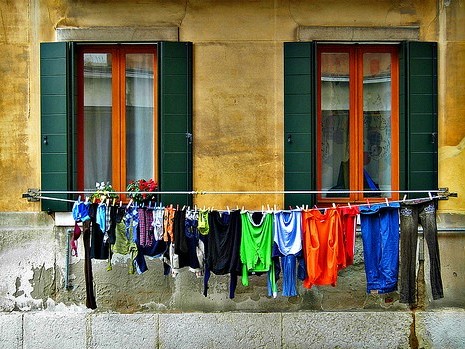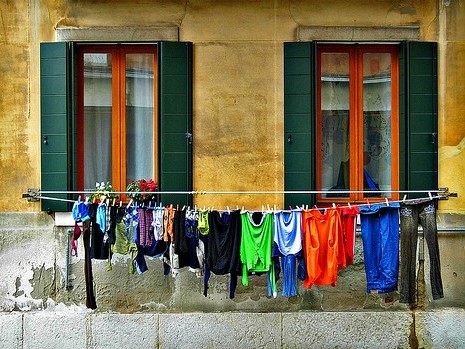 Photo: alessandraelle via Flickr
Photo: alessandraelle via Flickr
[UPDATE, 01 Jul 2010: Thanks to our many commenters for sharing your advice and experiences. We’ve randomly chosen a winner from your ranks: luinigh, you’ll soon be getting a green laundry kit in the mail!
Bummed out that you didn’t win the prize? Maybe you’ll be luckier if you enter Seventh Generation’s Laundry Challenge. Also, get more reasons and ways to green your laundry from Project Laundry List.]
[UPDATE, 22 Jun 2010: Just one more day left to tell us about your green laundry experience and get a chance to win a green laundry kit. Post a comment!]
With summer upon us, it’s the perfect time to reform your laundry habits. Will you take the Green Laundry Challenge?
1. First order of business: Skip the dryer and let your clothes blow in the breeze (or at least just hang loose).
Dryers are big household energy suckers — second only to refrigerators. A dryer will cost about $85 to operate annually; over its expected lifetime of 18 years, that adds up to $1,530. Get more info — and more reasons to line-dry — from Project Laundry List.
You don’t have to have a yard or a balcony to get in on the game. You can dry items indoors on a folding rack, like this or this. Grist advice guru Umbra Fisk offers more info on indoor racks. Or just string your laundry up outside your window, à la the photo above.
2. Wash in cold water. It gets your laundry plenty clean, we promise.
Heating water to wash clothes accounts for 90 percent of the energy that a washing machine uses. Washing your laundry for a year on hot or warm in a top-loading electric washer will result on average in 2,407 pounds of CO2 pollution — equivalent to a roundtrip, cross-country plane trip.
3. Use a nontoxic, biodegradable detergent.
Conventional laundry detergents contain all kinds of nasties like phosphates, surfactants, and bleach, which end up in waterways when they are drained from washing machines; these chemicals create algal blooms, expose wildlife to endocrine disruptors, and release corrosive chemicals, respectively. Look for biodegradable laundry detergents without phosphates or surfactants (NPEs). Instead, they will be made with plant oils and other natural ingredients that can biodegrade. Plus, eco-friendly detergents are easier on the skin and better for people who are sensitive to chemicals.
Also check out Umbra’s advice on laundry detergents — including DIY laundry detergent — and Grist’s review of six green detergents.
So … are you game? Try out the green laundry thing, then report back and tell us how it goes — you can post a comment below. Or if you already line-dry and greenify your laundry, share thoughts and tips right now.
After June 23, we’ll choose one lucky commenter to win a green laundry kit containing:
- A portable, collapsible laundry line — can be used indoors or outdoors
- A collapsible jute laundry basket
- Clothes pins
- A jug of Seventh Generation Natural 2x Concentrated Laundry Liquid
The kit — “retail value: $80” — is provided courtesy of Seventh Generation. Full disclosure: The company sent Grist one of these kits too. The collapsible laundry line is pretty neat.



